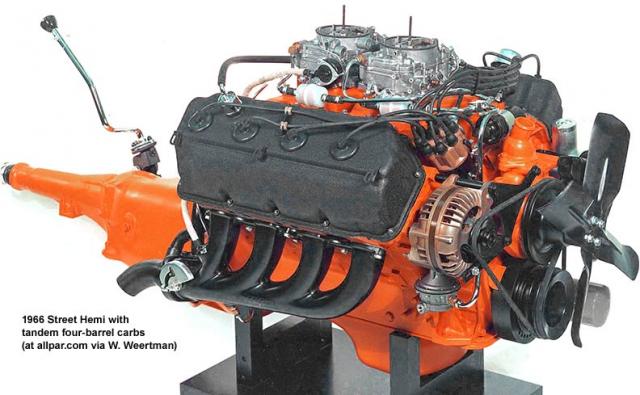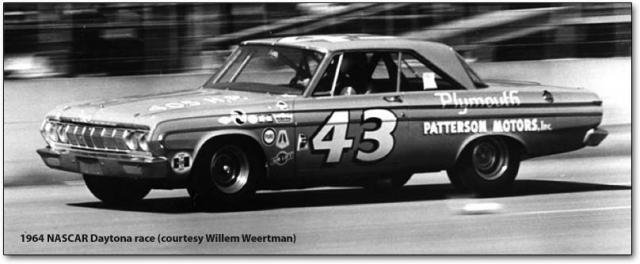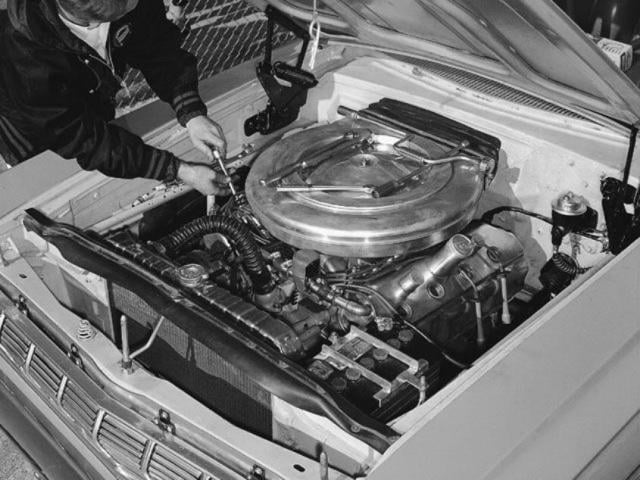In the automotive history books, surely you’ve heard about the 426 HEMI and how it’s the motor by which all others are compared. This is due to its storied history of development, competitive advantage, and horsepower output.
But would it surprise you to know that there were more HEMIs than the 426? No, we’re not talking about the FirePower HEMIs from the 1950s, but what’s known as the A117 and A148 HEMIs. Both evolved from the politics of NASCAR racing.
Like many automotive manufacturers after World War II, their experience building aircraft influenced automobile design and engineering. Chrysler was no different – while designing their first OHV V8 engine, engineers found hemispherical heads had better thermal and volumetric efficiency. By 1959, the Chrysler HEMI was no more, the victim of weight and manufacturing complexity. In 1964, that would change.
The 1962 introduction of the Max Wedge was Chrysler’s first serious competitive submission to the horsepower wars of the 1960s; sure, there were the cross-ram 383s from 1960-61, but they were not the 400-plus-horsepower monsters that competitive manufacturers had by 1962. Based on the 413 (the motor that replaced the 392 HEMI in 1959), the Max Wedge featured two four-barrel carburetors atop a cross-ram manifold that led to lots of wins on the drag strip. By 1964, the motor had grown to 426cui and was in its third incarnation (“Stage III”). The competition was fierce – even with GM bowing out of sanctioned racing – so with an escalation in NASCAR combined with inspiration from the past, engineers were given the green light to add HEMI heads to the RB-series 426. This motor was coded A864.
Debuting at Daytona in 1964, Chrysler’s NASCAR Hemi swept the top three spots and a legend was born. Success in drag racing showed that the 426 HEMI was no fluke. However, the powers that be at NASCAR (Bill France and his minions) shuffled the rules due to a number of factors: competitive complaints from Ford, speed complaints from the Automobile Manufacturers Association, and even several deaths in NASCAR’s 1964 season.
Hence, for 1965, NASCAR homologation requirements put Chrysler at a competitive disadvantage, resulting in Chrysler’s withdrawal in protest. Meanwhile, Chrysler’s engineers tried to find a solution since the mantra “Win on Sunday, sell on Monday” was very relevant. One of those solutions was to offer the production A102 “Street HEMI” for 1966, giving 2,700 performance fans the ability to be kings of the street and strip. But there were other solutions.
A117 and A148 HEMIs
NASCAR’s homologation rule changes may have screwed up Chrysler’s mojo, but the company continued its quest for racing dominance through sanctioned drag racing – with great success. Then, on June 15, 1965, NASCAR rescinded their complete ban on the HEMI, specifically stating that it had sought “to eliminate the high cost/low volume special engines from competition.” There still were conditions to be met, however, including a reduction in size. By the end of July, Chrysler returned to NASCAR with the A117 HEMI.
Based on the A864 426 HEMI that killed all comers in 1964, the A117 had a shorter, 3.558-inch stroke and requisite crankshaft. With this “handicapped” HEMI, engineers worked to develop new ways to make up for lost horsepower, such as different camshaft and intake manifold designs. The new “Bathtub” intake manifold was the result of the latter, which also allowed for better hood clearance; this item – also used on 426 HEMI applications – delivered the power necessary to keep Chrysler #1. Another concession to NASCAR rules was that A117-equipped cars were relegated to short tracks.
The A148 HEMI, in turn, was an outgrowth of the A117 in a quest to gain more rpms and torque. According to a Performance Planning letter dated December 2,1965, the engine specs required larger intake and exhaust valves. In an interview with Chrysler engineer Stewart Pomeroy, “It was in essence a 1965-1966 426 race HEMI prototype based on the shorter stroke of the A117 but with a larger bore (4.363 in) and larger valves. Both aluminum alloy and iron cylinder heads were tested with, along with a gear-driven cam and a flat crankshaft.” It’s quite possible that Chrysler’s decision to create the A102 Street HEMI for homologation purposes also put the nail in the coffin in the A148.
The A148 never went beyond the prototype stage, and the A117’s tenure wasn’t long. It’s not that it was unsuccessful but, rather, NASCAR decided fostering competition was in everyone’s interest, so the 426 HEMI returned for 1967. It was limited to a single 4 bbl. carburetor while Ford’s 427 had a 2×4 arrangement, giving an advantage to the Blue Oval. In response, Chrysler used the lighter A117 and won the championship. It wouldn’t be till April, 1968 that Chrysler would be able to use a 2×4 carburetor arrangement, but by then, the “Aero Wars” were gaining momentum, which is another story unto itself.






















